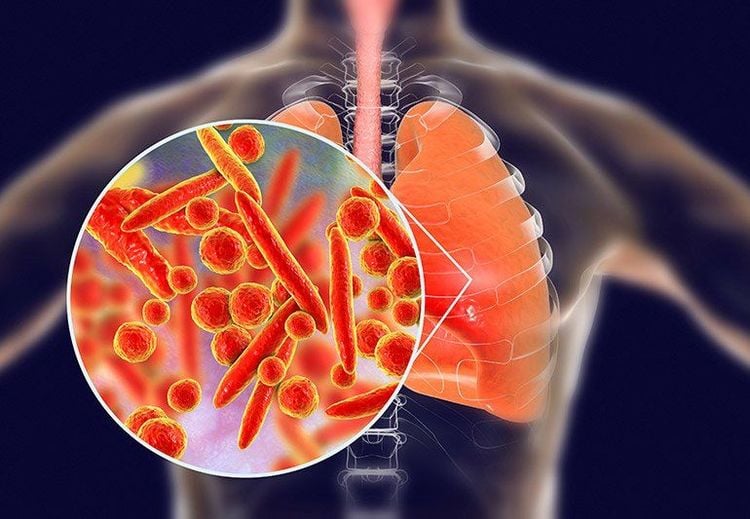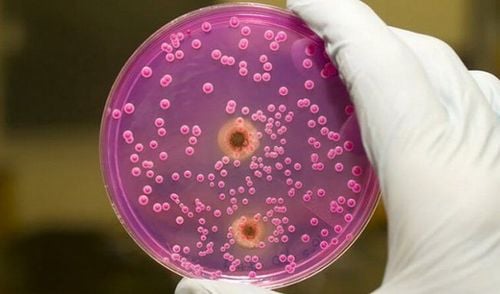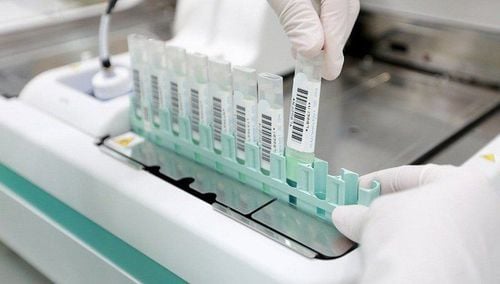This is an automatically translated article.
Mycoplasma bacteria is a strain of bacteria that normally resides in the lining of the oral cavity, throat and genital tract in both sexes. When there is an increase in number, they will carry the ability to cause diseases, most commonly pneumonia caused by Mycoplasma infection. To definitively diagnose this pathology, the doctor will assign the patient to conduct a test for Mycoplasma.
1. Overview of Mycoplasma
In 1898, two scientists Roux and Nocard discovered Mycoplasma bacteria in the body of a cow with pneumonia. This is a small, diverse bacteria with a lack of cell walls. With an extremely small size of only 0.15-0.3 μm, scientists cannot observe it under ordinary microscopes but must use fluorescence microscopes or black background microscopes.
2. Pathogenicity of Mycoplasma
If Mycoplasma invades and parasitizes our body, this bacterium will reside in the lining of the oral cavity, throat and genital tract in both sexes. When there is an increase in numbers, they will carry the ability to cause disease. There are 4 common diseases caused by Mycoplasma bacteria:
Respiratory tract infections, atypical pneumonia caused by Mycoplasma infections: This is a common disease in patients aged 5 to 20 years old. The time when the disease can spread into an epidemic is usually in late summer and early autumn. If the patient has a Mycoplasma respiratory infection that causes a persistent cough, it may progress to pneumonia. In particular, pneumonia caused by Mycoplasma is capable of being transmitted through the respiratory tract. Urethritis (not related to gonorrhea): The usual route of infection is through sexual contact. Genitourinitis: Can cause gynecological infections in women (vaginitis, fallopian tubes, ovaries, uterus, ...) after miscarriage. This is a sexually transmitted disease. UTIs (not related to gonorrhea): The usual route of infection is through sexual contact. For the treatment of diseases caused by Mycoplasma infections, antibiotics are the first choice of treatment. Mycoplasma strains have weak resistance to antibiotic groups, so they can be naturally resistant to cephalosporin, vancomycin, and penicillin antibiotics.
MORE: Vinmec successfully treated 2 children with severe pneumonia caused by mycoplasma

Vi khuẩn Mycoplasma gây viêm phổi ở người nhiễm
3. Symptoms of Mycoplasma infection
With a mean incubation period of 3 weeks, symptoms in patients with Mycoplasma infection will develop slowly and quietly. Initially, within a few days to a few weeks, the sick person has flu symptoms including: low-grade fever below 38 degrees Celsius, or high fever chills but not chills, headaches and sore throat are very uncomfortable. Besides, in the lungs and outside the lungs also have specific symptoms.
Pulmonary manifestations include:
Non-infectious, toxic facial expressions; The patient has mild pharyngitis, without secretions, with or without cervical lymphadenopathy; In children younger than 2 years old, hemorrhagic labyrinthitis or red eardrum (otitis media) may occur; Persistent cough or pleurisy causing chest pain. The patient has a dry cough or little sputum; Although lung examination is normal, due to temporary increased bronchial reactivity, a few weeks later, snoring, moist rales may be present. Extrapulmonary manifestations:
Meningoencephalitis; Pericarditis , pericardial hemopericarditis , myocarditis , congestive heart failure ; Skin: erythema multiforme (bubble, maculopapular) and hemorrhage; Gastrointestinal: nausea, vomiting, diarrhea, acute pancreatitis. Because respiratory infections caused by Mycoplasma do not have specific symptoms, it is difficult to make a differential diagnosis, and most patients are not diagnosed early. Mycoplasma pneumoniae is an atypical pneumonia, so it has different symptoms than other common viral pneumonia. Only when the disease persists, doctors will rely on extrapulmonary signs to make a diagnosis.
4. Meaning of the Mycoplasma test
Currently, scientists have not yet developed a vaccine that can help prevent Mycoplasma infection. Therefore, conducting an early Mycoplasma test as soon as abnormal signs are detected in the body can bring a good prognosis for treatment.
Mycoplasma test will help timely detect dangerous diseases caused by Mycoplasma bacteria (pneumonia, urethritis, urinary tract infection, ...)
4.1. Specimens Patients will have throat swabs, sputum, pus or urinary and genital secretions taken by the nurses to diagnose Mycoplasma. Because Mycoplasma bacteria have the property of adhering to the surface of host cells, the specimen must contain live cells. To perform a Mycoplasma test, the specimen must contain live cells. 4.2 Staining Because Mycoplasma bacteria are too small in size to be observed under a conventional microscope. Therefore, the endoscopic staining method has no diagnostic value.
4.3 Culture Due to Mycoplasma culture conditions, it takes a long time in particular because the growth rate of bacteria is very slow, so it is often difficult to do culture. Conditions for culture: nutrient-rich culture medium, incubation time is about 24-48 hours, background temperature is 37 degrees Celsius and contains 10% CO2. With some strains of Mycoplasma, the time required for culture is about 2 to 3 weeks longer.

Vi khuẩn Mycoplasma cần được nuôi cấy trong môi trường giàu chất dinh dưỡng
4.4. Serological diagnosis It is possible to detect the presence of IgM and increase the titer of IgG through the ELISA test, thereby having a basis for diagnosing the disease in the acute stage.
4.5. Through the Mycoplasma DUO kit to identify Mycoplasma bacteria in the urogenital tract After growing in a suitable environment, a mixture of products containing Mycoplasma bacteria will be dropped into wells containing arginine or urea substrates. As a result, the ability of Mycoplasma bacteria to use arginine and urea will be discovered. At a temperature of 37 degrees Celsius, if after a period of 24-48 hours, the indicator changes color, the patient is positive for Mycoplasma.
Mycoplasma infection is very dangerous if not detected, diagnosed and treated promptly. Therefore, when the body has symptoms of infection, the patient should immediately go to a reputable medical facility to examine and perform a test for Mycoplasma. Early detection of the disease is extremely beneficial, helping to improve the effectiveness of treatment and promptly limit the consequences that the disease causes.
Previously, the diagnosis of Mycoplasma bacteria based on culture method or measurement of IgG and IgM antibody titres in serum often gave late results. At Vinmec International General Hospital, diagnosis of Mycoplasma disease by PCR amplification molecular genetic technique gives fast and accurate results after 8 hours.
With the strength of a highly specialized team, right from the moment the patient is admitted to the hospital, doctors at Vinmec International General Hospital have performed an examination and accurately diagnosed the cause of the disease. Thanks to modern equipment, especially high molecular genetic testing technique using PCR gene amplification technique to identify pathogenic bacteria within 8 hours, the patient was accurately diagnosed in a short time. short on admission and has a good prognosis.
Please dial HOTLINE for more information or register for an appointment HERE. Download MyVinmec app to make appointments faster and to manage your bookings easily.













